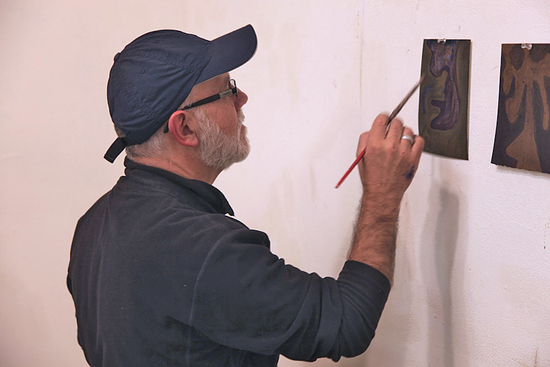Joël LeVasseur working on soil-based paintings in Harmony Hammond's class, Painting Studio, Anderson Ranch Arts Center, Snowmass, Colorado.
Photo by Annaday Hiser, Old Snowmass Village, Colorado
__________________________________________
Photo by Annaday Hiser, Old Snowmass Village, Colorado
__________________________________________
Joël LeVasseur is a multidisciplinary, environmental, artist based in mid-coast Maine. He holds a B.S. from Husson University and an MFA from Vermont College of Fine Arts. He has been included in many shows internationally, including the Center for Maine Contemporary Art Biennial. He has participated in several Percent for Art Projects in the State of Maine, where his work is on permanent display. His teaching experience has been at the University of Maine at Fort Kent, Freshwater Arts, where he created and led a Printmaking Marathon for several years, Maine College of Art, Drawing Room of Portland, Maine, Haystack Mountain School of Crafts Studio-Based Learning, and Farmington Technology Center. He has held plein-air painting workshops, through the University of Maine, on Monhegan Island, Quebec City, and along the St. Lawrence Seaway in Canada. He has collaborated with several artists on projects such as Ocean Stories, which travelled throughout Europe and Canada, and later on The Last Book/Ultimo Libro with conceptual artist, Luis Camnitzer, sponsored by the National Library of Spain, and which travelled internationally including Zurich, Switzerland, and Buenos Aires, Argentina.
___________
I am a multidisciplinary artist based in mid-coast Maine. Much of my creative process for ideas and source of materials come from walking and scavenging materials discarded, and left on Maine's beaches, state parks, and along highways. Through subtle symbolism of trajectories and scars across a tortured landscape, and use of discarded materials and industrial goods, as templates for printmaking, and ideas for painting and installation work, my work focuses primarily on primordial origins, void, and chaos; all of which I interpret as fragments of a vanishing earth.
I am concerned about the continuum of man-made landscape; “interrupted forests”, abandoned or temporarily placed objects in landscape, encroachment and, more recently, technology obstructions in rural landscape – all reminders of loss of a natural environment.
The question is not always easy to answer as to what our sense of responsibility is for the survival of the earth. My own search has led me to confront ways, through various perspectives, of revealing the elements of what has become “ordinary” landscape, no longer bucolic.
Walking in the paths of Hopper, Marin, Hartley, and others in search of the sublime, and through privileged views, having flown from a Bell 47 helicopter over environment parallel to major tourist routes, leading to Acadia National Park, I have experienced many changes in landscape. In my ongoing investigation and art practice, my intent is to provoke, gently, how we quickly become accustomed to man-made landscape, no longer pristine – not wild.
___________
I am a multidisciplinary artist based in mid-coast Maine. Much of my creative process for ideas and source of materials come from walking and scavenging materials discarded, and left on Maine's beaches, state parks, and along highways. Through subtle symbolism of trajectories and scars across a tortured landscape, and use of discarded materials and industrial goods, as templates for printmaking, and ideas for painting and installation work, my work focuses primarily on primordial origins, void, and chaos; all of which I interpret as fragments of a vanishing earth.
I am concerned about the continuum of man-made landscape; “interrupted forests”, abandoned or temporarily placed objects in landscape, encroachment and, more recently, technology obstructions in rural landscape – all reminders of loss of a natural environment.
The question is not always easy to answer as to what our sense of responsibility is for the survival of the earth. My own search has led me to confront ways, through various perspectives, of revealing the elements of what has become “ordinary” landscape, no longer bucolic.
Walking in the paths of Hopper, Marin, Hartley, and others in search of the sublime, and through privileged views, having flown from a Bell 47 helicopter over environment parallel to major tourist routes, leading to Acadia National Park, I have experienced many changes in landscape. In my ongoing investigation and art practice, my intent is to provoke, gently, how we quickly become accustomed to man-made landscape, no longer pristine – not wild.

